The Facebook Pixel is a bit of code that you can put into a website in order to monitor user behavior. And also collect data for marketing purposes. This is for advertising purposes. It is possible to use it to track conversions, analyze ads’ success, and generate particular audiences for future advertising efforts on Facebook. After uploading the code on their website, creating custom events to measure interaction, and setting up the Pixel in the Facebook Ads Manager, businesses are ready to start using the Pixel.
What Is Facebook Pixel?
You may add a snippet of code, the Facebook Pixel, to a website to track site visitors’ actions. And also collect data that can be for to target advertisements more effectively. It assists businesses in monitoring the behavior of their customers. And refining their advertising efforts and developing niche markets for future marketing endeavors. User interactions with a website are all recorded by the pixel. Such as which pages are visible, which goods are added to a shopping cart, and which sales are made. Following the collection of this data, you may optimize Facebook advertising to communicate more effectively with its intended audience. In addition, you may utilize the pixel. To construct retargeting audiences composed of individuals who have previously engaged with the company’s website. When considering everything, the Facebook Pixel is a powerful tool that businesses can use to boost the efficiency of their Facebook advertising.
The Facebook Pixel will be helpful for businesses and advertisers who use Facebook for promotional purposes. It is now possible for all types of businesses to track the performance of their Facebook advertising activities and to retarget past site visits. This includes online stores, traditional storefronts, and business-to-business operations. The Facebook Pixel is an excellent tool that you can use to improve conversion rates. Also, fine-tune advertising campaigns, and collect data that may be valuable to inform future advertising decisions. Learn how to create Facebook ads.
What Does Facebook Pixel Do?
In its most fundamental form, a Facebook pixel links the data and actions of a website visitor to that person’s Facebook profile. This is the primary function of a Facebook pixel. This information may be practical for several different uses. These include optimizing the performance of advertisements, retargeting users, and increasing conversion rates. Utilizing analytics from social media marketing to better understand your target customers is one of the essential components of growing your brand’s online presence. And it’s also one of the most critical aspects of social media marketing analytics.
After you install and set it to monitor the behavior of users on your website, it will begin operating automatically in the background. It will operate to do so unless you specifically configure it to give you extra control over the data it collects. It is possible to illustrate the impact that social media marketing has on websites.
You can decide to build a group of audiences that are distinct from one another. You can do this in only a few areas to ensure that you target the appropriate folks each time you start a new campaign. Even if you are not currently advertising on Facebook, the information that the pixel collects is still beneficial. In addition, if you are considering venturing into the world of advertising at some time in the not-too-distant future, configuring the pixel now will make it possible for you to investigate the many internet data alternatives that will improve your future advertisements. Because the pixel may store data for up to 180 days, also, obtaining the data as soon as possible is preferable rather than waiting. Check Facebook advertising strategies for more.
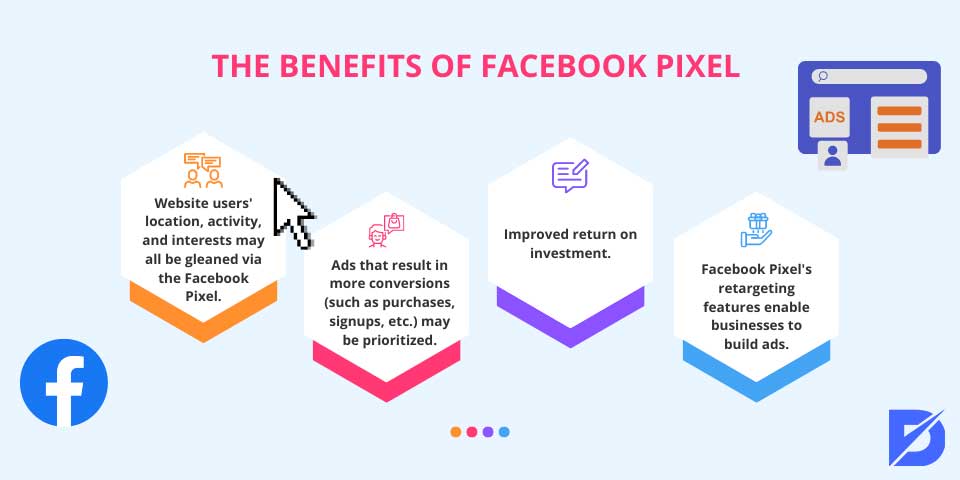
The Benefits Of Facebook Pixel
When used correctly, Facebook Pixel may help businesses and marketers monitor the effectiveness of their Facebook ads. The use of Facebook Pixel has several advantages, such as:
- Website users’ location, activity, and interests may all be gleaned via the Facebook Pixel. Allowing for a more refined focus on the ideal customer. Using this information, we can craft more specific ads that will only be visible to the appropriate individuals at the right time.
- Ads that result in more conversions (such as purchases, signups, etc.) may be prioritized. The overall conversion rate can significantly increase if a company knows how visitors interact with their website. It’s possible that this will increase conversion rates and bring forth more fruitful marketing campaigns.
- Improved return on investment. With Facebook Pixel’s data, companies can make educated decisions about their ad spend. These include modifying their budget or targeting to receive the best possible results from their marketing efforts. A more fruitful advertising campaign and higher ROI are both possible results.
- Facebook Pixel’s retargeting features enable businesses to build ads that are visible just to those who have previously visited their website. Inviting customers to return to a company’s website and maybe make a purchase or do some other desired action can be accomplished with this method.
Opens Up Facebook Analytics
By enabling Facebook Analytics, Facebook Pixel gives businesses access to a wealth of information on their Facebook advertising.
Beneficial insights about the target audience are one such advantage. With Facebook Analytics, a company may learn not just basic demographic information like age, gender, and region. But also specifics about their target audience, such as their likes, dislikes, and purchasing habits. Using this data, companies may improve their advertising efforts so that they reach the appropriate individuals at the right time.
Tracking your conversions is another perk. Companies can use Facebook Analytics to see how many people clicked on their advertising. And also made a purchase or signed up for their newsletter. Companies may get a better return on their advertising dollars using this information.
The Facebook Analytics funnel analysis feature is beneficial. Companies may learn more about the client journey and the points at which leads are being lost. Businesses may use this data to enhance the consumer experience and boost sales.
Ad impressions, clicks, and conversions are just some metrics a company can track by using Facebook Analytics. Advertisers may use this information to target their audiences better and spend their money. In addition, businesses may get a more in-depth look at their target demographic. And also the results of their advertising campaigns by commissioning individualized data analysis and reports.
The analytics are helpful for all website administrators. But especially so for e-commerce business owners because they reveal critical information about the success of their stores. A better view of things such as:

- What factors influence your website’s popularity?
- Visitors’ referring domains and IP addresses (For instance, SEO Traffic).
- Demographics of the target audience.
- Insights into your website’s traffic flow using Facebook’s analytic tools.
- Retention of Users.
- The Customer Lifecycle.
- High-quality material.
Online shops also have access to information on the following:
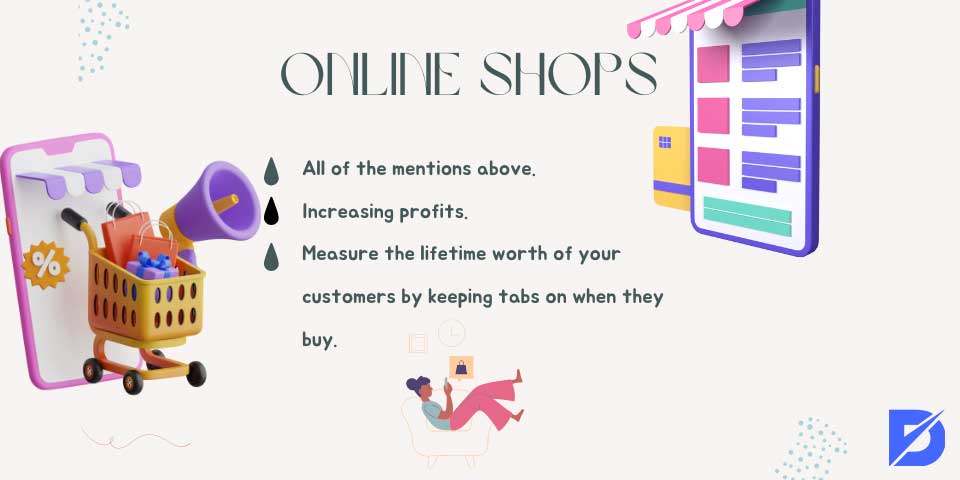
- All of the mentions above.
- Increasing profits.
- Measure the lifetime worth of your customers by keeping tabs on when they buy.
Facebook Ads Result Optimization and Conversions With Pixel Events
The process of utilizing Pixel Events to track and enhance the efficacy of Facebook advertising is described as “Facebook Advertisements Result Optimization and Conversions using Pixel Events.” This is a phrase that was coined to characterize the procedure. “Pixel Events,” which are distinct user interactions with a website, are what is recorded by the Facebook Pixel so that this may be accomplished.
Pixel Events provide for the recording of a variety of actions. Including the viewing of a product, the addition of that product to a shopping cart, and the completion of a purchase. Utilizing this information may be beneficial for advertising efforts. And as well as optimizing advertising spend and achieving a higher return on investment.
When a firm, for example, uses Facebook advertisements to improve product sales, they may utilize a feature called Pixel Events to track which users saw which product pages. And also which ones led to actual transactions. This allows the company to determine which ads were most successful. The firm will be able to adjust its strategy based on the findings of this data. This will show them which forms of advertising are the most successful. Conversion rates, return on investment, and the efficiency of marketing initiatives all have the potential to improve as a result of this.
Another use of Pixel Events is the retargeting of advertisements on Facebook. Pixel Events is a tool that assists companies in collecting data on the actions of website visitors. With this information, companies are better able to cater their advertising efforts to the preferences of customers who have already demonstrated an interest in a specific good or service. This has the potential to be a successful approach for attracting clients to return to a company’s website. And also for the complete a purchase or other activity that is necessary for them.
In conclusion, the Facebook Pixel and Pixel Events are to measure the effectiveness of Facebook advertising. This enables the optimization of ads and an increase in the number of users who convert as a result of the optimization. It is possible that this strategy will increase conversion rates, return on investment, and the targeted nature of advertising efforts.
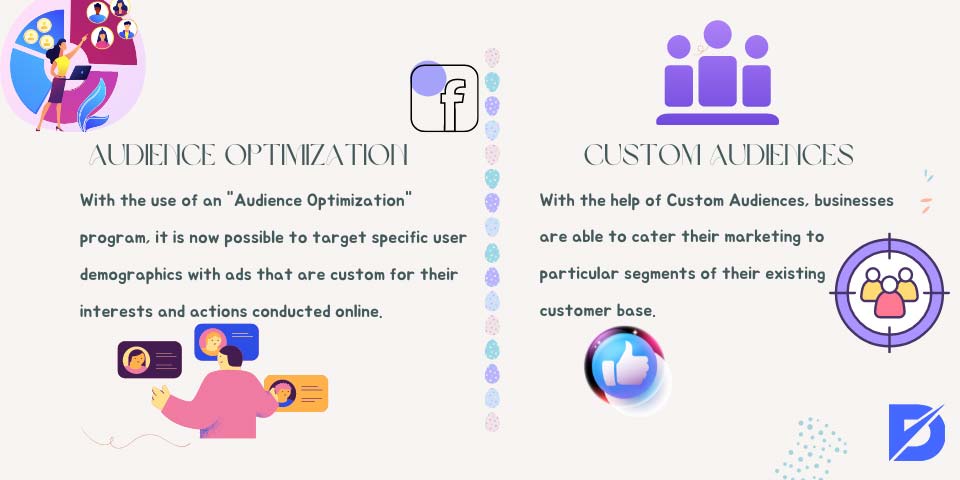
Audience Optimization and Custom Audiences
The audience optimization and custom-audience options that are available on the Facebook Pixel are particularly helpful for reaching and connecting with customers. With the use of an “Audience Optimization” program, it is now possible to target specific user demographics with ads that are custom for their interests and actions conducted online. For instance, if a firm sells equipment for outdoor activities like hiking and camping, it may direct its marketing efforts exclusively to those interested in participating in those pursuits. Because of this, it is possible to have a higher degree of contact with the advertisement.
However, with the help of Custom Audiences, businesses are able to cater their marketing to particular segments of their existing customer base. A few examples of this sort of data include addresses, phone numbers, and handles on various social media platforms. When a business cultivates a tailored audience, it has the ability to restrict the delivery of adverts to customers who have previously interacted with the brand in some capacity. These are such as making a purchase or signing up for a newsletter. This technique has the potential to raise conversion rates and boost ROI. And because the demographic that is being targeted is already familiar with the company’s brand and is more likely to convert as a result.
The use of either Audience Optimization or Custom Audiences, both of which are major techniques, may make advertising campaigns more relevant to their target audiences and more effective overall. With the use of these technologies, businesses have the potential to raise both the number of people who see their adverts and the level of attention that those advertisements create. Combining Audience Optimization and Custom Audiences with other Facebook Pixel tools, such as conversion tracking and funnel analysis, enables businesses to obtain a more in-depth look into their intended demographic. As well as the efficacy of their advertising. This is a bonus feature that is available to businesses.
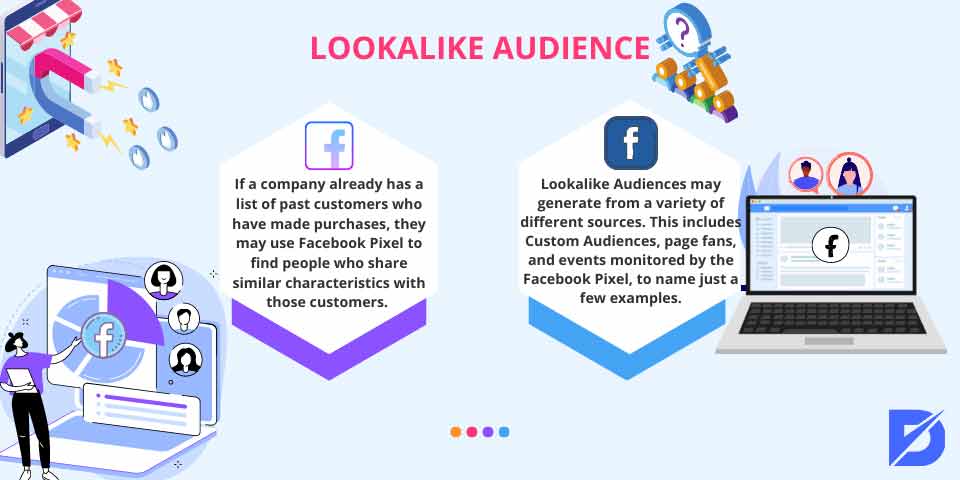
Lookalike Audiences
By utilizing the Lookalike Audiences capability of the Facebook Pixel, businesses are able to discover and engage with new leads that are comparable to their existing customers. In order to accomplish this goal, data from the Facebook Pixel, as well as data from other sources, are utilized to establish commonalities among an existing customer base or target demographic. Next, new users that meet this profile are found and pursued.
If a company already has a list of past customers who have made purchases, they may use Facebook Pixel to find people who share similar characteristics with those customers. In terms of interests, habits, and demographics. For example, if a company already has a list of customers who have made purchases in the past, they may find people who share similar interests. It is possible that the company’s capacity to reach new potential customers who are more interested in its products or services would result in higher engagement rates and more productive advertising campaigns.
Lookalike Audiences may generate from a variety of different sources. This includes Custom Audiences, page fans, and events monitored by the Facebook Pixel, to name just a few examples. In order for businesses to improve their ability to target people similar to their existing audience, they have the choice of either shrinking or growing the size of the Lookalike Audience.
Utilizing lookalike audiences may help firms expand their customer base and increase the number of people with whom they interact. Combining this capability with others that Facebook Pixel supplies, such as conversion tracking and funnel analysis, may provide companies with more information on the demographic they are trying to reach, as well as the advertising efforts they are making.

Where to Get Facebook Pixel?
The Facebook Pixel provides access to sophisticated tools and capabilities that can improve your advertising’s ability to find and connect with its intended audience. You can get your hands on the Facebook Pixel from the Facebook Ads Manager. Here’s what you can do to access Pixel:
- Access the Facebook Ads Manager by visiting your profile and selecting the “Ads Manager” option from the drop-down menu.
- Establish an Ad Account: If you don’t currently have an ad account, you’ll need to create one. The “Create” button in the Ads Manager will lead you through the necessary steps.
- Once you have an ad account, navigate to the Pixels section of the Ads Manager and click the “Create Pixel” button to set up a Facebook Pixel.
- After generating the Pixel, you’ll need to add it to your site so that it may begin collecting data. This may be possible by copying and pasting a code snippet given by Facebook into the header of your website. The Pixel may also be added to a website with the use of a plugin or tag manager.
- Verify the Pixel: Finally, you’ll need to verify that the Pixel is operating properly. For this step, using a Facebook Pixel Helper, a browser plugin, may be effective for checking the Pixel’s functionality and making sure it is accurately monitoring events.
How to Install and Setup Facebook Pixel
The Facebook Pixel has a number of typical installation and configuration processes depending on the platform you’re using. In case you’re interested, we’ve included comprehensive guides for setting up the Facebook Pixel on Google Tag Manager (GTM), Spotify, and WordPress.

Installation of Google Tag Manager (GTM) and the Facebook Pixel
When you use Google Tag Manager, managing and setting up the Facebook Pixel on your website is really simple and straightforward. The following is an explanation of how to configure the Facebook Pixel in Google Tag Manager:
- If you haven’t already, create a Facebook Pixel and then upload it to the Facebook Ads Manager, where you manage your ads.
- You are free to create a new tag in your GTM account at any time.
- Obtain your own unique Facebook Pixel ID, then insert it into the corresponding space on the Facebook Pixel template.
- Choose “Page View” as the event trigger, and then save the tag when you’ve done so.
- Take a peek at the completed work before putting it out for everyone to see.
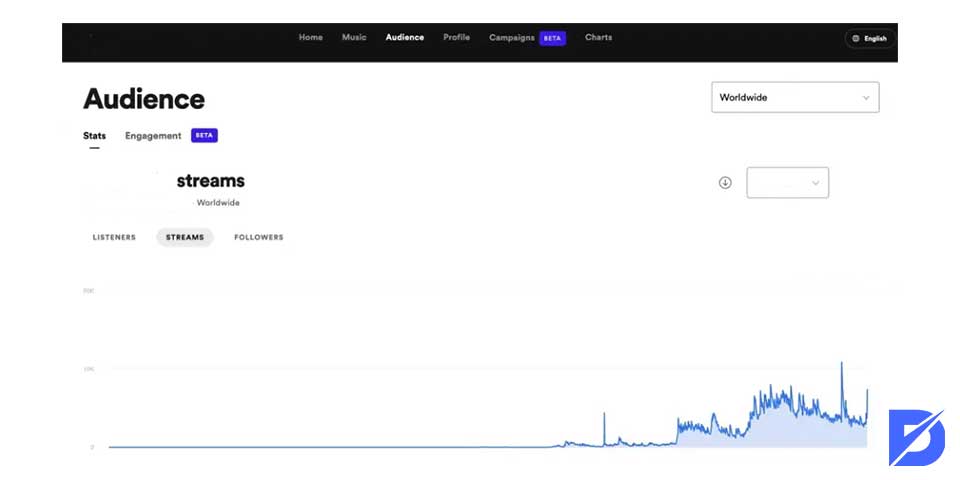
Putting the Facebook Pixel on Spotify
In order to put the Facebook Pixel into action on Spotify, you will need to have the code for the Facebook Pixel. The following are the methods:
- If you haven’t already, create a Facebook Pixel and then upload it to the Facebook Ads Manager, where you manage your ads.
- From the menu of the Facebook Pixel, select “Set Up” to retrieve the code for the Pixel.
- To immediately implement your brand on Spotify, just copy and paste the code into the top of the app.
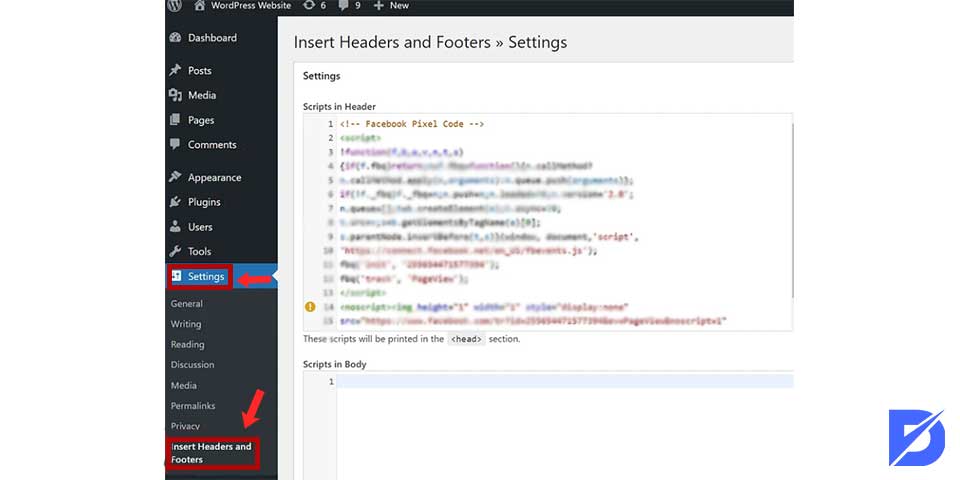
Setting Up the Facebook Pixel for a WordPress Site
You may add the Facebook Pixel to a WordPress site in a number of different methods, either using a plugin or by hand-coding the necessary snippets of code. The plugin installation procedure for the Facebook Pixel is as follows:
- If you haven’t previously done so, make a Facebook Pixel and upload it to your Facebook Ads Manager.
- Set up the “Insert Headers and Footers” add-on and turn it on.
- Copy the Facebook Pixel code and paste it into the plugin’s settings header.
- Once you’ve made the necessary modifications, you may use the Facebook Pixel Helper to see if the Pixel has taken effect.
Once you install the Facebook Pixel, data collection will begin, and you’ll have access to all of Facebook’s tools and services for ad optimization and conversion tracking. If you want your Pixel to keep working as it should, you should routinely check and update its settings. Learn all about Facebook for business.
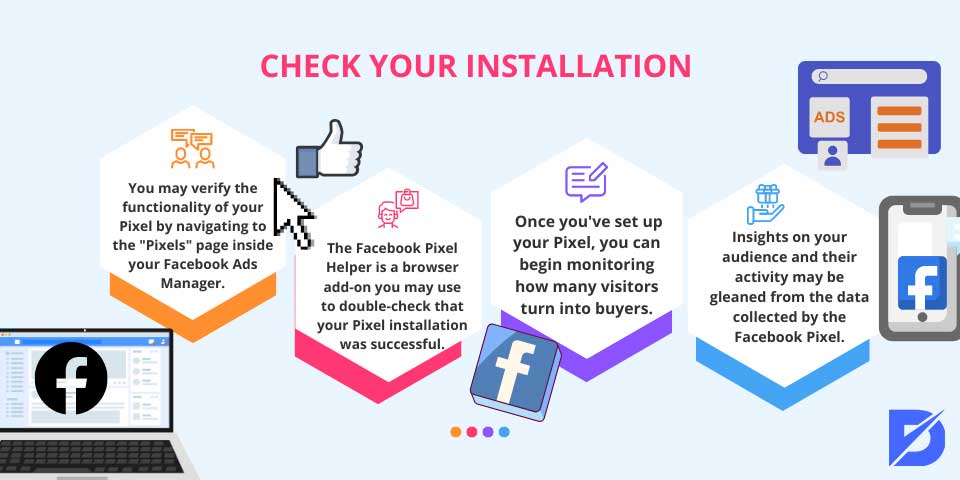
Check Your Installation
Confirm that your Facebook Pixel is up and running once you have installed it. A few things to keep in mind are:
- You may verify the functionality of your Pixel by navigating to the “Pixels” page inside your Facebook Ads Manager. The number of page views and events recorded should be displayed here.
- The Facebook Pixel Helper is a browser add-on you may use to double-check that your Pixel installation was successful. As soon as the Pixel Helper recognizes a Pixel on a website, it will provide you with details on the Pixel’s status and any problems it may be having.
- Tracking Conversions: Once you’ve set up your Pixel, you can begin monitoring how many visitors turn into buyers. In order to accomplish this, you will need to create conversion events and specify what counts as a conversion. You can then verify that your events are being tracked adequately by checking the conversion data in your Facebook Ads Manager.
- Insights on your audience and their activity may be gleaned from the data collected by the Facebook Pixel. This information might help you refine your advertising strategies and reach your intended demographic.
In the event that your Pixel is malfunctioning, troubleshooting is a must. Make sure that your Pixel code is set up properly and firing on the right pages falls under this category. You can also use the Facebook Pixel Helper for troubleshooting.
You can make sure your Facebook Pixel is collecting data reliably. And also delivering useful insights into your audience and advertising efforts. You can do this by validating your installation and checking for faults on a regular basis.
Conclusion
In conclusion, the Facebook pixel’s primary function is to boost advertising performance on the platform. At the same time, secondary benefits include enhanced website performance thanks to the data gathered from visitors. You’ll lose more than you think without it, even if you don’t run ads on Facebook. You can accomplish find new development opportunities and realize the aims of a better online business. This is possible via the manner by which we collect data and utilize it to examine the present state of businesses and websites. To reap the benefits of Facebook Pixels, many organizations may rapidly get started actively in business thanks to its low barrier to entry. And since the pixel is free, easy to install and set up, and, most importantly, to analyze and use. A pixel is an essential tool for internet marketers and organizations. Whether it’s for advertising, optimizing websites, or improving conversion funnels.
Frequently Asked Questions About
As part of their advertising strategy, Facebook offers website owners a piece of code that is “Facebook Pixel.” It is for monitoring and analyzing visitor activity.
Installing a “Facebook pixel” on your website lets you track Facebook advertising efforts. This analytics tool shows how visitors interact with your website to evaluate advertising efforts.
You may enhance the efficacy of your Facebook ads by connecting your Meta Pixel with Google Tag Manager.
You don’t have to pay for a Pixel code because it is free. Facebook Pixel is a free helper for your ads and tracking their effectiveness.
Facebook Pixel is really helpful for your Facebook ads and tracking their achievements, especially for free.




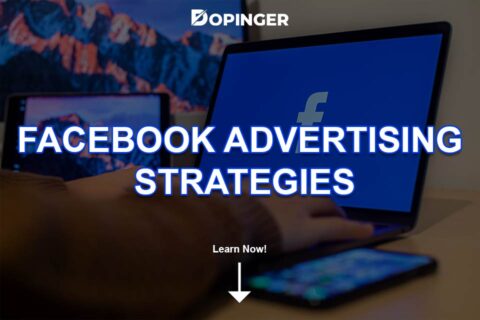
No comments to show.